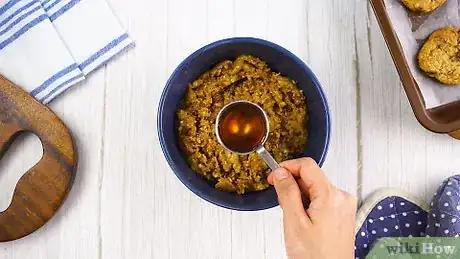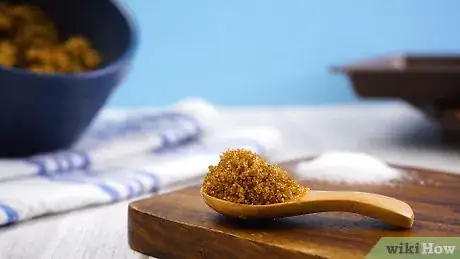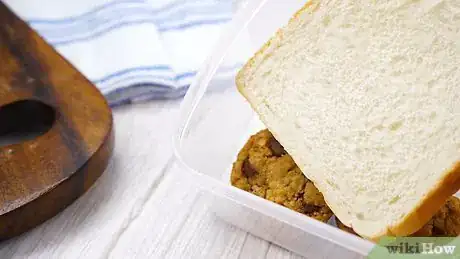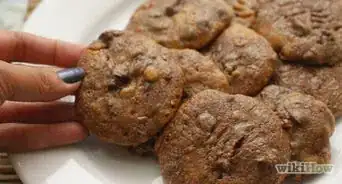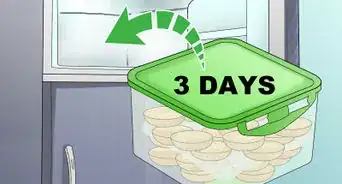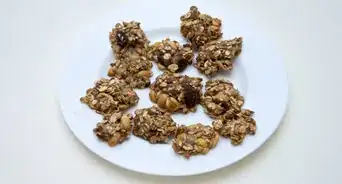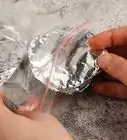This article was co-authored by wikiHow Staff. Our trained team of editors and researchers validate articles for accuracy and comprehensiveness. wikiHow's Content Management Team carefully monitors the work from our editorial staff to ensure that each article is backed by trusted research and meets our high quality standards.
There are 11 references cited in this article, which can be found at the bottom of the page.
The wikiHow Culinary Team also followed the article's instructions and verified that they work.
This article has been viewed 96,288 times.
Learn more...
Everyone loves a dense, chewy cookie, and creating one doesn’t have to be difficult. The main difference between a chewy cookie and a crispy one is that a chewy cookie has more moisture. By making ingredient substitutions, using certain baking techniques and storing your cookies well, you can create chewy, soft cookies every time.
Steps
Adding or Substituting Ingredients in Your Recipe
-
1Add molasses or honey to your cookies. Adding a tablespoon of molasses (21g) to your cookie dough will increase the cookies’ moisture content, giving them a soft, chewy texture. If you’re not fond of molasses’ deep flavor, try a tablespoon of honey.[1]
- Don’t add multiple tablespoons of liquid sweetener like the ones listed because they will make your cookies runny and too sweet. One tablespoon is enough to make your cookies softer but not disrupt the integrity of the dough.
-
2Substitute brown sugar for white sugar. Brown sugar is more moist than white sugar, so using it gives a chewier result. Replace the white sugar in your recipe 1-1 with brown sugar. This will also give your cookies a deeper, more caramelized flavor.[2]Advertisement
-
3Use recipes that call for shortening instead of butter. Butter contains fat, milk solids and water, whereas shortening is 100% pure fat. Using butter in cookies (due to the water) actually creates steam during the baking process, drying your cookies slightly. Shortening will create a chewier, more tender result. If you want to replace butter with shortening in a recipe, do so with a 1-1 ratio.[3]
-
4Substitute an egg yolk for an egg white. This means that for each egg a recipe calls for, you would use two yolks instead. Yolks have more fat than egg whites, increasing the fat content of your cookies and keeping them moist.[4]
-
5Opt for recipes with baking powder over baking soda. Baking powder is more acidic than baking soda, which means your cookies will spread less. This will prevent excess moisture loss as the cookie thins.[5]
Using Baking Techniques to Increase Chewiness
-
1Turn down the temperature on your oven. Many cookie recipes call for an oven temperature of 350 degrees F (176 degrees C) or higher. These hot temperatures cause your cookies to lose lots of moisture—and chewiness—in the baking process. Seek out recipes that call for an oven of around 325 degrees F (162 degrees C) to keep your cookies moist.[6]
-
2Bake your cookies for less time. If you have a cookie recipe you like but the cookies turn out crunchy, try baking the cookies for slightly less time. If you take your cookies out when the exterior edges are golden brown but the centers are set but not brown, the cookies will be fudgier.[7]
-
3Rest your dough in the fridge before baking. Chilling your dough in the fridge for at least an hour makes some water evaporate from your cookies, giving your dough a higher sugar content. This slightly higher sugar content will keep your cookies moist and chewy.[8]
- The longer you rest your dough, the chewier the cookies. Professional bakers often rest their dough for several days to get the desired chewy texture. Don’t go longer than a week in the fridge though.
Storing Cookies for Chewier Texture
-
1Allow cookies to cool completely, but don’t leave them out. Before storing your cookies, allow them to cool completely on the baking sheet. Then, store them promptly once they reach room temperature. Leaving them out will encourage them to dry out.[9]
-
2Store cookies in an airtight container. To keep your cookies their most chewy and moist, store them in an airtight container such as a cookie jar with a lid or a Tupperware. If you don’t have either of those, a Ziplock bag will do just fine.
- Make sure your cookies are not hot when you store them. Storing hot cookies in an airtight container will cause the cookies to fall apart.[10]
-
3Add a slice of fresh bread to your storage container. To keep your cookies chewy and moist longer, add a slice of fresh sandwich bread to your storage container with the cookies. This will add moisture to the container, which the cookies will absorb. You’ll know the method is working because the next day your slice of bread will be dried out like a piece of toast, and your cookies will be soft and chewy.[11]
Community Q&A
-
QuestionCan I make the cookie platter the night before the party?
 kelseyCommunity AnswerYes, you can, just make sure they are covered or in an air tight container so they don't get stale.
kelseyCommunity AnswerYes, you can, just make sure they are covered or in an air tight container so they don't get stale. -
QuestionHow do you make cookies cakier?
 Community AnswerUse less flour, and bake them for less time. Also, make your cookies bigger in size so the center gets really cakey.
Community AnswerUse less flour, and bake them for less time. Also, make your cookies bigger in size so the center gets really cakey.
References
- ↑ http://www.sunset.com/food-wine/techniques/perfect-chocolate-chip-cookie
- ↑ http://www.saveur.com/article/Techniques/Cakey-vs-Chewy
- ↑ https://www.thekitchn.com/shortening-vs-butter-in-cookies-whats-the-difference-213812
- ↑ http://www.seriouseats.com/2015/12/cookie-science-how-do-eggs-affect-my-cookies.html/
- ↑ http://bakerbettie.com/baking-101/baking-powder-and-baking-soda/
- ↑ http://sweets.seriouseats.com/2013/12/the-food-lab-the-best-chocolate-chip-cookies.html
- ↑ http://www.finecooking.com/item/27253/the-science-behind-the-perfect-cookies
- ↑ http://blog.kingarthurflour.com/2015/05/17/chilling-cookie-dough/
- ↑ http://startcooking.com/chewy-or-crunchy-how-to-get-the-cookies-you-want
About This Article
To make cookies chewy, try adding a tablespoon of honey or molasses to the dough before you bake the cookies. You can also replace the white sugar in the recipe with brown sugar since brown sugar contains more moisture. Also, try replacing the egg whites with egg yolks so you have 2 yolks for every 1 egg that the recipe calls for. To learn how to store cookies so they stay chewy for longer, scroll down!
